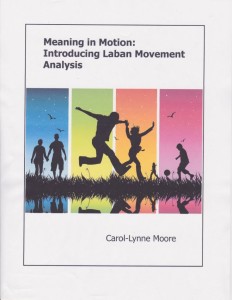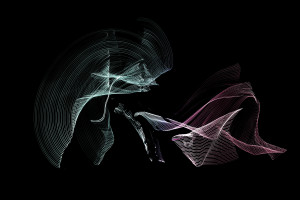 by Nancy Beardall
by Nancy Beardall
At Lesley University we use Carol-Lynne Moore’s book, Meaning in Motion: Introducing Laban Movement Analysis in both our Dance Movement Therapy masters program and the Laban/Bartenieff Certificate program housed at Lesley. Students are introduced to and read the primary source material written by Laban, Bartenieff, Dell, Lamb, North, etc., however, students appreciate the concise and clear text as presented in Meaning in Motion. Moore’s guidebook was one I was pleased to offer students as many of them are learning the material for the first time.
Carol-Lynne’s expertise is vast and the LMA system is described comprehensively making it accessible for the students. There are also experiential exercises that assist them in their overall understanding of the material helping to integrate “meaning in motion.” The students find the book helpful in applying the LMA material to specific dance/movement therapy case studies or projects.
Students speak highly of Moore’s relatable style and often quote Moore in papers they write, an indication of their comfort and confidence in her mastery of the Laban Movement Analysis system. I highly recommend, Meaning in Motion.

 “Meaning in Motion is one of the few, if not the only, contemporary texts to integrate historical, theoretical, and creative frameworks for understanding and studying Laban Movement Analysis,” writes Dr. Andrea Harris, University of Wisconsin, Madison.
“Meaning in Motion is one of the few, if not the only, contemporary texts to integrate historical, theoretical, and creative frameworks for understanding and studying Laban Movement Analysis,” writes Dr. Andrea Harris, University of Wisconsin, Madison. I didn’t start out to write an introductory Laban Movement Analysis text. It began as a compilation of teaching materials I’ve developed over the last three decades, teaching in Certificate Programs in New York, Chicago, Seattle, Los Angeles, Salt Lake City, Berlin, The Netherlands, and England.
I didn’t start out to write an introductory Laban Movement Analysis text. It began as a compilation of teaching materials I’ve developed over the last three decades, teaching in Certificate Programs in New York, Chicago, Seattle, Los Angeles, Salt Lake City, Berlin, The Netherlands, and England. The diversity of applications of movement analysis showcased at the June conference in Montreal was awesome. And that is just the beginning….
The diversity of applications of movement analysis showcased at the June conference in Montreal was awesome. And that is just the beginning…. In my discussion of Movement Pattern Analysis (MPA) at the public lecture session in Montreal, I aimed to demonstrate how knowledge from the field of dance became relevant and valued in the business world.
In my discussion of Movement Pattern Analysis (MPA) at the public lecture session in Montreal, I aimed to demonstrate how knowledge from the field of dance became relevant and valued in the business world. The Montreal event included a full morning of various presentations on applications of
The Montreal event included a full morning of various presentations on applications of  The June gathering in Montreal of American, Canadian, and French movement analysts provided many opportunities for moving, observing, and talking together. This was a daunting enterprise, for not only were participants navigating between two systems of movement analysis but also two languages – English and French.
The June gathering in Montreal of American, Canadian, and French movement analysts provided many opportunities for moving, observing, and talking together. This was a daunting enterprise, for not only were participants navigating between two systems of movement analysis but also two languages – English and French. As one of 12 Laban Movement Analysts who participated in a 2014 research project comparing our observations with those of 12 experts in the French system of Functional Analysis of the Dancing Body (AFCMD), I was keen to hear the preliminary results of the study.
As one of 12 Laban Movement Analysts who participated in a 2014 research project comparing our observations with those of 12 experts in the French system of Functional Analysis of the Dancing Body (AFCMD), I was keen to hear the preliminary results of the study. During the first week of June, I participated in unique collegial exchange with fourteen other movement analysts from the U.S., Canada, and France. Hosted by the Dance Department of the University of Quebec at Montreal, the seminar provided an opportunity for comparative and comprehensive study of two approaches to qualitative movement analysis:
During the first week of June, I participated in unique collegial exchange with fourteen other movement analysts from the U.S., Canada, and France. Hosted by the Dance Department of the University of Quebec at Montreal, the seminar provided an opportunity for comparative and comprehensive study of two approaches to qualitative movement analysis: 